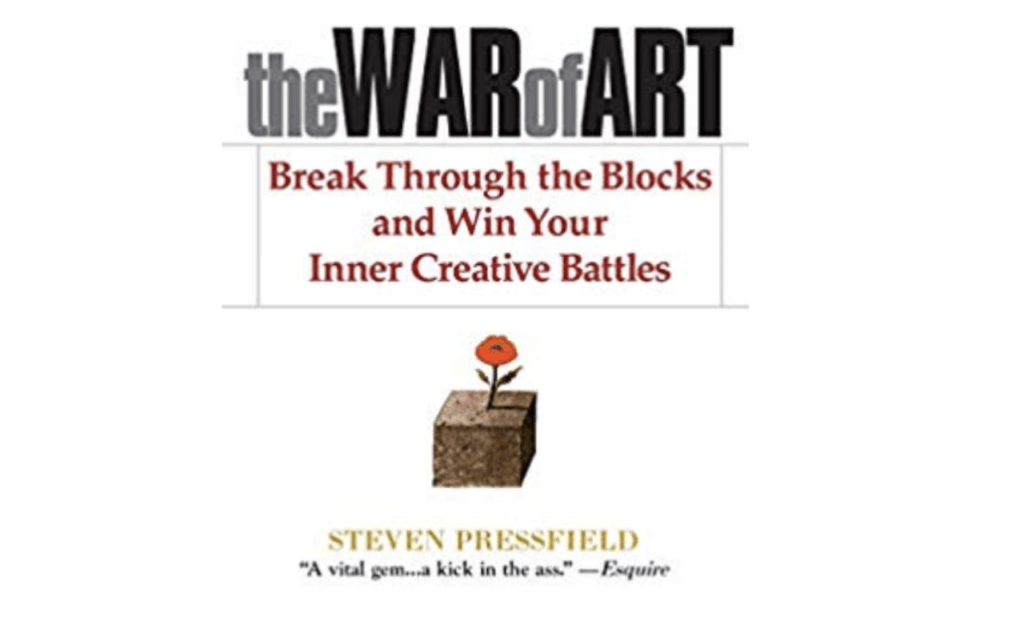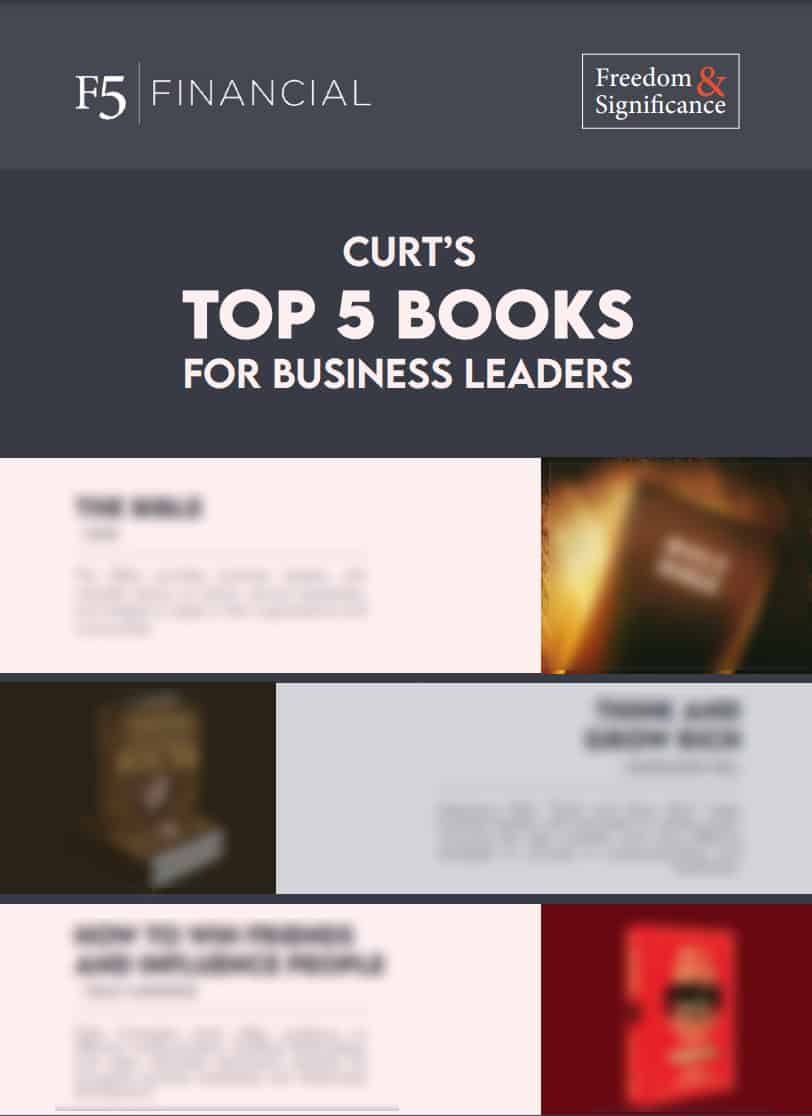
Book Summary – The War of Art

The War of Art by Steven Pressfield
While I am not ready to name Steven Pressfield’s The War of Art my all-time favorite book, it has definitely claimed a spot in the top three. We all struggle with the challenge of starting and staying with tasks. Pressfield digs in to why this is the case, what we can do to overcome what he calls “the resistance,” and finally frames the struggle to stick with those things important to us in the context of our relationship to a higher power in life.
On the surface this sounds a bit esoteric and impractical; however, Pressfield presents the material in a crisp, concise writing style that is easy to read, easy to understand, AND easy to apply.
The challenge of resistance—and how to overcome it
The first two sections of The War of Art explain the challenge and describe how to overcome it. These two sections alone would make the book a “must read.” However, it is the third section where the book really shines. Pressfield frames the topic of why we struggle with resistance in the context of our relationship with a higher power.
Coming to a better understanding of our relationship with everything!
He describes how, through our struggles with resistance, we come to better understand our relationship with everything around us. I literally cannot do justice to this section and have found new insights within this final section each time I have re-read the book. It’s that good.
To me, the best books are the ones that I WANT to re-read. The War of Art definitely falls in that category. Below, I’ve provided some additional details about the book. However, you really need to pick this one up and go through it page by page. You will be glad you did.
Introduction – Pressfield’s personal war of art
Pressfield starts the book with a brief introduction. In it, he describes what he does (writes / creates art), why that is important to him (because in so doing he overcomes self-doubt and uses his gift), and why this is important in the broader context (we need to use our gifts to live fully).
Stepping up to the challenge
He lets the reader know that it is a struggle for him to stick to this seemingly simple task, and that we should not be surprised that we likely struggle as well. He describes the basic struggle as “resistance,” and, the remainder of the book is focused on understanding and overcoming resistance. He closes the introduction by suggesting that while it is incredibly difficult to face the resistance, we will only be happy if we step up to the challenge and do just that.
Book One: Resistance – defining the enemy
In book one, Pressfield takes us through all of the ways that resistance manifests itself. Unfortunately, they are all too easy to recognize! The sections include:
- A listing of the 11 most common activities where we face resistance. These include creative endeavors, entrepreneurial ventures, diets, spiritual growth, a better stomach, bad habits, education/learning, moral challenges, helping others, following our heart, and taking a stand when faced with adversity.
- A description of all the things resistance is, including:
- Invisible, internal, insidious
- implacable (i.e. relentless),
- impersonal, infallible, universal.
- A description of how resistance acts, including how it is always awake, playing for keeps, fueled by fear, only opposing in one direction, and becoming stronger as we near the end of the task at hand.
- A description of resistance’s “allies” (i.e., things that act as distractors / feed resistance), including procrastination, sex, getting in trouble, self-dramatization, self-medication (substance abuse), and victimhood.
- A description of the emotional states we experience or feel that feed resistance, including unhappiness (depression), fundamentalism (craving the past), criticism, self-doubt, fear, indifference, isolation, support (neediness), and rationalization.
These challenges are both familiar and universal.
The key to this section is that the various challenges he describes related to resistance are well known to each of us. That is important for two reasons. First, it shows us that we already know and understand resistance. Second, it shows us that we are not unique in our struggle with resistance. These two things give us hope that we can stand up to resistance. And in book two, Pressfield tells us how . . .
Book Two: Combatting resistance – turning pro
In book two, Pressfield highlights the key traits and behaviors of those who decide to “turn pro.” By turning pro, he refers to facing resistance and taking the steps to overcome it. He paints a picture that is based on simplicity, persistence, and hard work. That is not necessarily a popular message in today’s society, as many people are looking for quick fixes that do not require any effort.
Being a professional – not a romantic undertaking
At the heart of being a professional versus an amateur is a desire to totally commit to your pursuit. That means working on it full-time and being totally committed to the pursuit versus doing the activity. He points out that this is NOT a romantic undertaking.
Four key elements in a professional’s day
He describes the professional’s day with four key items. First it is built around the important but not urgent items (this comes from Steven Covey and is great advice!). Second, the day is not going to be easy. It will be a challenge to start due to the enemy resistance. Third, if you stick to it and push through, you will get to that magical flow state where things become easy, and you start to produce your art. Fourth, you will end the day knowing that tomorrow is going to be just as challenging, and that you must mentally prepare yourself for the challenge.
As he puts it, the professional “just does the work”—interesting that Nike chose the “Just Do It” tagline! It is NOT a “sexy” existence being a professional. That is where many go wrong and fail—they think that somehow the professional has it “easy.” That is simply not the case. He points out that the creation of a professional often involves passing through extreme challenges and points folks to the process the Marines use with young recruits.
We are already professionals at work – now, how about our art!
One of the key points in this section is that we are all already professionals. The reality is most every one of us has a job we go to where we are considered “pros.” We do the job well, we take it seriously, and we have the respect and admiration of our co-workers. Unfortunately, many of us are “pros” in the wrong “sport”. He points out that we go through the process and suffering at our day jobs because of the paycheck. The key question that we each need to ask is why are we so unwilling to do the same for our passion? We have proven that we know how to be successful—how to be a pro—we just are unwilling to face down the resistance and turn professional (i.e., give the time and effort) in the area of our passion.
The 18 characteristics of a true professional
Pressfield describes the key traits/characteristics of a “professional” – including playing for the love of the game, accepting delayed gratification, being disciplined, understanding that there is no magic bullet/that it is simply hard work, acting in the face of fear, accepting no excuses, accepting the bad breaks and moving on, being prepared, not showing off (why we love Tim Duncan!), dedicating himself to mastering the technique, not hesitating to ask for help, not taking failure (or success) personally, enduring adversity, self-validating, recognizing her limitations, is recognized by other professionals, and never stops going/is always persistent.
No mystery – an act of will
Pressfield closes book two with a section called “No Mystery”:
- “There’s no mystery to turning pro. It’s a decision brought about by an act of will. We make up our mind to view ourselves as pros and we do it. Simple as that.”
It really is that hard. It really is that simple.
Book Three: Beyond resistance – higher realm
As mentioned earlier, the first two parts of The War of Art make the book worth reading. It is the third part, however, that really shows Pressfield’s depth of insight. In part three, he turns his attention to the how and why we are able to overcome resistance. He makes a wonderful set of arguments that we are able to overcome resistance due to the gift that we are given from, AND our relationship with, some higher power.
God, angels, and muses
He dares to speak of angels and muses as well as God. He suggests that through pursuing our passion, we connect with the broader world and realize our potential. Finally, he makes the argument that it is our duty to pursue our passion, as that is the reason that God put us on this Earth and to do anything less would be sacrilege. Book three is a fascinating read that makes you think and offers an explanation as to why the battle with resistance is so challenging and so important.
3 Key sets of dualities
Pressfield introduces us to the “higher realm” through a series of dualities. The key dualities are:
- Ego vs. Self. Pressfield introduces the concept of “ego” as our conscious being versus our “self” being our subconscious and unconscious being. However, he also argues that our “self” subsumes the ego as well. He suggests that “angels and muses” live in our self, while resistance lives in our ego.
- Finite vs. Infinite. The finite is the limited collection of things that we can see with our physical senses. Conversely, the infinite is all that we cannot see. The finite is connected with our ego, while the infinite is connected with our self. This positioning aligns with the traditional view of a soul (self) that will live on beyond death.
- Hierarchy vs. Territory. Hierarchy describes our relative relationships with others. It defines us in terms of these relationships. Hierarchy is associated with the ego. Territory describes our relationship with the broader world. It defines our position in relationship to everything versus simply with those things immediately around us. Territory is associated with self.
Our infinite self - beyond hierarchical comparisons
Once he has defined these dualities, he is able to offer his perspective on our relationship to the “higher realm” he refers to in the third book’s title. He describes his view of the world order by tying together “self-infinite-territory” versus “ego-finite-hierarchy”. He arrives at the conclusion that self is the territory of angels and muses and that they are infinite. Conversely, the ego exists only hierarchically (in relation to others) and is finite.
Implications of Pressfield’s work – applications for your life
The implications associated with Pressfield’s ordering of things are numerous. They include:
- We each have an incredible power within our self to create.
- This power to create is uniquely ours.
- Those around us make it difficult to embrace this power within.
- The more we create, the more we connect with our self, the easier things become.
- As we create, we connect to the higher realm. That is good for us AND good for the higher realm.
- We need to create for our self—which is directly connected to the higher realm—versus for others.
- We must create.
- While the higher realms exist, they cannot be proven to exist.
- Resistance is going to continually be at work to deny the existence of the higher realms.
- The artist needs to be a warrior.
Pressfield closes with a brief section titled “The Artist’s Life.” In it, he makes the argument that we are each born with a gift and to not use that gift is a waste. He offers that for the sake of our self, for the sake of others, and for the sake of God, you need to use that gift. Amen.
If you would like to have a copy of this summary in PDF form to share with others, you can click here.
If you liked this post, you might want to check out these as well:
F5 Financial
F5 Financial is a fee-only wealth management firm with a holistic approach to financial planning, personal goals, and behavioral change. Through our F5 Process, we provide insight and tailored strategies that inspire and equip our clients to enjoy a life of significance and financial freedom.
F5 Financial provides fee-only financial planning services to Naperville, Plainfield, Bolingbrook, Aurora, Oswego, Geneva, St. Charles, Wheaton, Glen Ellyn, Lisle, Chicago and the surrounding communities; to McDonough, Henry County, Fayette County, Atlanta and the surrounding communities; to Venice, Sarasota, Fort Myers, Port Charlotte, Cape Coral, Osprey, North Port, and the surrounding communities; and nationally.
We'd love to have the opportunity to hear about your situation. Contact us here to schedule an appointment for a consultation.
Learn more about What We Do.
Helping You With
Wealth Preservation – Wealth Enhancement – Wealth Transfer – Wealth Protection – Charitable Giving


